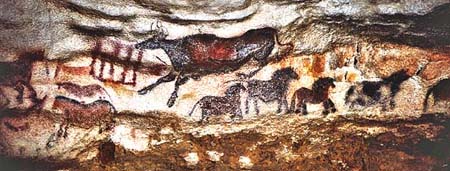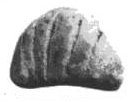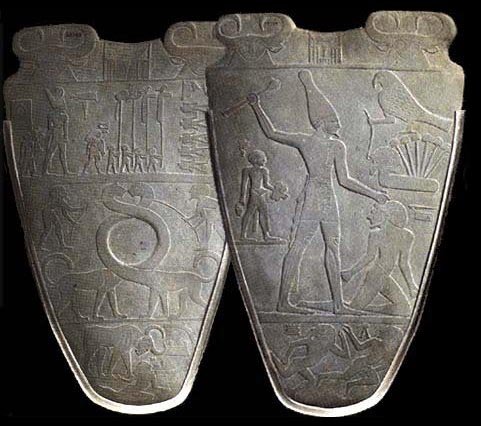 |

Language existed long before writing, emerging probably simultaneously with sapience, abstract thought and the Genus Homo. In my opinion, the signature event that separated the emergence of palaeohumans from their anthropoid progenitors was not tool-making but a rudimentary oral communication that replaced the hoots and gestures still used by lower primates. The transfer of more complex information, ideas and concepts from one individual to another, or to a group, was the single most advantageous evolutionary adaptation for species preservation. As long ago as 25,000-30,000 years BP, humans were painting pictures on cave walls. Whether these pictures were telling a "story" or represented some type of "spirit house" or ritual exercise is not known.
The advent of a writing system, however, seems to coincide with the transition from hunter-gatherer societies to more permanent agrarian encampments when it became necessary to count ones property, whether it be parcels of land, animals or measures of grain or to transfer that property to another individual or another settlement. We see the first evidence for this with incised "counting tokens" about 9,000 years ago in the neolithic fertile crescent.
Around 4100-3800 BCE, the tokens began to be symbols that could be impressed or inscribed in clay to represent a record of land, grain or cattle and a written language was beginning to develop. One of the earliest examples was found in the excavations of Uruk in Mesopotamia at a level representing the time of the crystallization of the Sumerian culture.
The pictures began as representing what they were, pictographs, and eventually, certain pictures represented an idea or concept, ideographs, and finally to represent sounds.
head foot sun "day" hand woman Eventually, the pictographs were stylized, rotated and in impressed in clay with a wedge shaped stylus to become the script known as Cuneiform. The pictograph for woman, as seen above became
.
Written language was the product of an agrarian society. These societies were centered around the cultivation of grain. A natural result of the cultivation and storage of grain is the production of beer. It is not surprising, therefore, that some of the very oldest written inscriptions concern the celebration of beer and the daily ration alotted to each citizen.
Early cylinder seal depicting beer production
It's tempting to claim that the development of a writing system was necessitated by the need to keep track of beer, but perhaps we can be satisfied that it was just part of it.
The signs of the Sumerians were adopted by the East Semitic peoples of Mesopotamia and Akkadian became the first Semitic language and would be used by the Babylonians and Assyrians. The Akkadian characters continued to represent syllables with defined vowels.
For the next step toward the development of an alphabet, we must go to Egypt where picture writing had developed sometime near the end of the 4th millennium BC. One of the earliest examples is the name of NAR-MER, either the first or second Pharoah of an united Egypt in 3100 BCE. The name appears as two syllabic figures between the cows' heads on the Kings cosmetic pallete.
First glyph "Nar" (Egyptian "monster fish," "cuttle fish.")
Second glyph "Mar" is a pictograph of a drill or borer
Unlike Akkadian, the Egyptian syllabic system had no definitive vowels. Some hieroglyphs were biliteral, some triliteral. Others were determinatives that at the end of the word gave a sense of the word and others were idiographs. Eventually, however, certain Egyptian hieroglyphs such as
which was pronounced r'i meaning "mouth" became the pictograph for the sound of R with any vowel. The pictograph for "water" pronounced nu
became the symbol for the consonantal sound of N. This practice of using a pictograph to stand for the first sound in the word it stood for is called acrophony and was the first step in the development of an ALPHABET or the "One Sign-One sound" system of writing. The Egyptian consonants were:
A glottal stop similar to the Hebrew Alef Consonantal Y, like the Hebrew Yod Sometimes abbreviated as \ \, sound of Y or ee used in the last syllable Gutteral sound corresponding to Hebrew Ayin W or U, corresponds to Hebrew Waw Sound of B Sound of P Sound of F Sound of M Sound of N Sound of R Sound of emphatic H Pharyngeal H, like Hebrew Het Like German CH as in ich Sound of Z Sound of S SH, Corresponds to Hebrew Shin Q, corresponds to Hebrew Qof Sound of K Hard G Sound of T Sound of TCH, as in hatch Sound of D Sound of DJ, or Hebrew Tsade See banner below as source of hieroglyphs The Egyptians used the acrophones as a consonantal system along with their syllabic and idiographic system, therefore the alphabet was not yet born. The acrophonic principal of Egyptian clearly influenced Proto-Canaanite/Proto-Sinaitic around 1700 BC. Inscriptions found at the site of the ancient torquoise mines at Serabit-al-Khadim in the Sinai use less than 30 signs, definite evidence of a consonantal alphabet rather than a syllabic system.
This is the alphabet that was the precursor to Phoenician, Greek and Roman. Meanwhile, in the North another experiment in a consonantal alphabet was taking place. Excavations of the ancient city of Ugarit, modern Ras Shamra, has produced texts in a cuneiform script that was also consonantal. In the order of the Alef-Beyt:
The Semitic languages diversified along geographic lines as Northwest Semitic, Northeast, Southwest and Southeast. Northwest Semitic consists of 2 major groups, Aramaic and Canaanite. Canaanite is represented by Ugaritic, Phoenician, and Hebrew. Northeast Semitic consists of the ancestral Akkadian, represented by Babylonian and Assyrian. The Southwest and Southeast Semitic languages consisted of North and South Arabic and Ethiopic.
The term epigraphy is generally used for writing on hard durable materials such as stone or postsherds (ostraca) but some use the term for any inscriptional remnants of a past civilization.
Palaeography is the study of the progressive changes and developments in the form of letters over time and is usually applied to writing on less durable materials such as parchment, leather or papyrus. An experienced palaeographer can often date a specific manuscript with fair accuracy. Epigraphy on stone is usually harder to date since more archaic forms were often retained for monumental inscriptions. The causes of changes in scripts were primarily sociological and psychological, a script hand being a reflection of styles and trends for particular time periods. Unfortunately, this is not measurable for the palaeographer whose primary tool is a systematic collection or database of thousands of exemplars of written material of known date.
Spelling and the sequence of characters in a word and their setting in a grammatic structure is the provenance of Orthography.
Using the fonts I have created for classroom work by my various scholar friends in the discussion lists, I have arranged the following inscriptions of Genesis 1:1 to display the development of the Semitic scripts since the 10th century BCE.


















 Donald
Ryan's
Donald
Ryan's 
